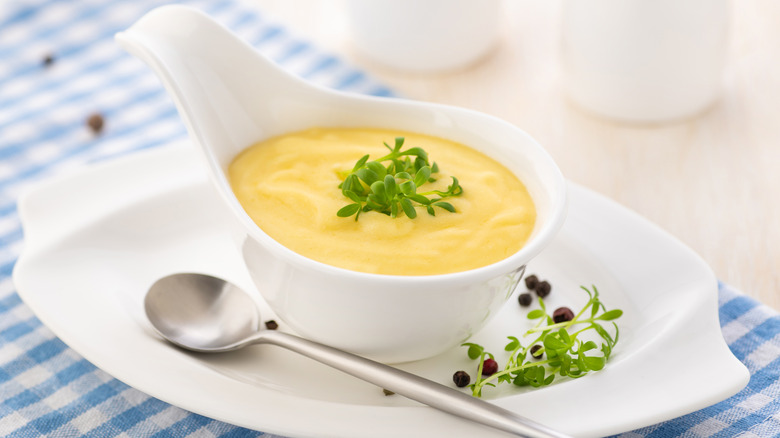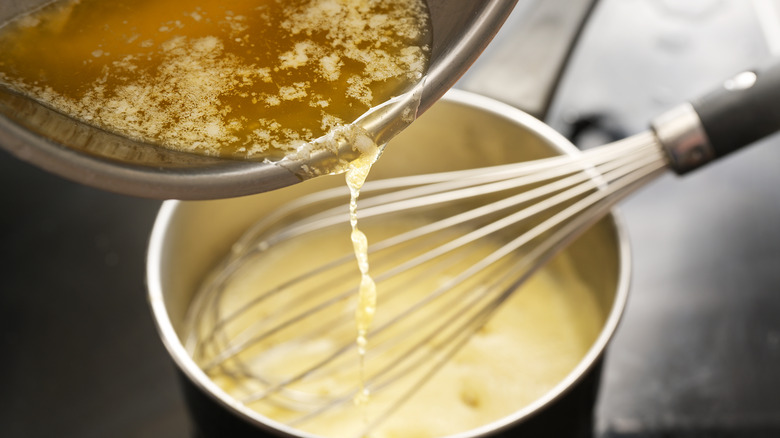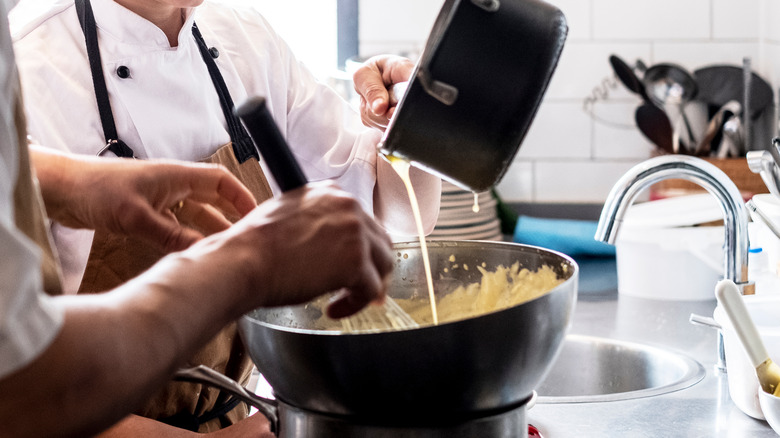Fix That Broken Hollandaise Sauce With Just One More Egg Yolk
Hollandaise sauce is notoriously frustrating and easy to screw up, mostly because of how it can be difficult to bring — and keep — together. How can it be so intimidating if you can make hollandaise in one minute with a blender? Hollandaise is known to break, meaning it loses its emulsion. Luckily, if you find yourself with a broken hollandaise, it's not the end of the world. As long as you have an extra egg yolk, that is.
Egg yolks contain the emulsifying agent lecithin, which holds fat and water together; this is why it's so helpful in hollandaise sauce and mayonnaise. If your hollandaise breaks, it's because your emulsion has fallen out of balance. As long as it's not coagulated (in other words, as long as you haven't accidentally scrambled your eggs), you can likely return its balance by whisking in an extra room-temperature egg yolk, thus adding more lecithin.
Worth noting is that this trick can make your hollandaise taste a bit eggy. While this may not sound appealing to some, the respected chefs of Joe Beef in Montreal, David McMillan and Fred Morin, use seven yolks in their hollandaise, so there's always room for one more. If you taste the extra egg and don't like it, rebalance your hollandaise with just a bit of melted butter and a couple of drops of lemon juice — not too much, though, or you'll end up with another broken hollandaise.
What makes a hollandaise break?
Hollandaise is comprised of butter, egg yolk, lemon juice, and a bit of water, which have to be combined vigorously at just the right temperature. The sauce is finicky and has many particularities, so while there are many reasons it could break, this also means there are multiple ways to fix it. You have to know which one you're dealing with; otherwise, you run the risk of making it worse.
If the butter is the wrong temperature, the hollandaise will have problems. Too cold and the fats start to solidify; too hot and the egg starts to scramble. You can't turn a scrambled egg back into hollandaise sauce, but if the mixture is too cold, you can gently heat it over a water bath or by whisking in a splash of hot water. If it's too hot and you catch it before it curdles, add a few drops of ice water to stop it from scrambling.
If there's too much butter and you can see the mixture becoming oily, whisk in a tablespoon of water. If that doesn't help, it's time to add another egg yolk and whisk rapidly to bring it back into emulsification: In a clean bowl over a pot of barely simmering water, whisk a yolk with a tablespoon of water. Slowly drizzle the broken sauce into the bowl, just as if you were starting from scratch, whisking vigorously. Hopefully, the sauce will re-emulsify, no problem.
What is an emulsion?
An emulsion is essentially two conflicting liquids that have to learn to get along. You may know that oil and water don't mix, but they can if you try hard enough. All you need is lots of agitation and some emulsifying agents. For vinaigrettes, this is often mustard. In mayo, this is often vinegar and the lecithin in egg yolks. And in hollandaise, it's lemon juice and, once again, the lecithin in egg yolks.
Some ingredients are already emulsifications. Butter is a solid emulsion of water and milk fat, and milk is a liquid emulsion of the same (but with more water). Egg yolks themselves are emulsions of fat and water, so mayo and hollandaise are simply emulsions made from other emulsions.
When you blend or whisk a fat and a non-fat liquid together, you have to provide the agitation necessary to emulsify them. On a microscopic level, little droplets of fat are suspended in the water, or vice-versa. This is what provides an emulsion's smooth, creamy consistency. If these elements fall out of balance, like if you freeze mayo or add too much of one ingredient, the emulsion is broken. Adjusting that balance will allow you to reunite these elements with more agitation. Adding an emulsifier like lecithin helps keep the mixture in suspension longer.


